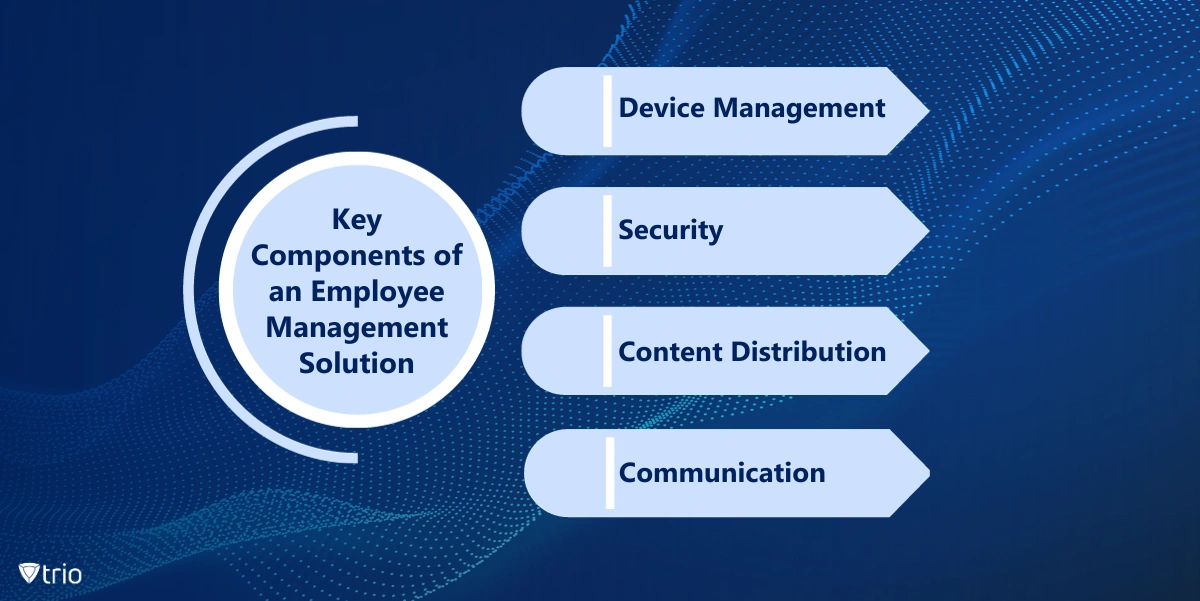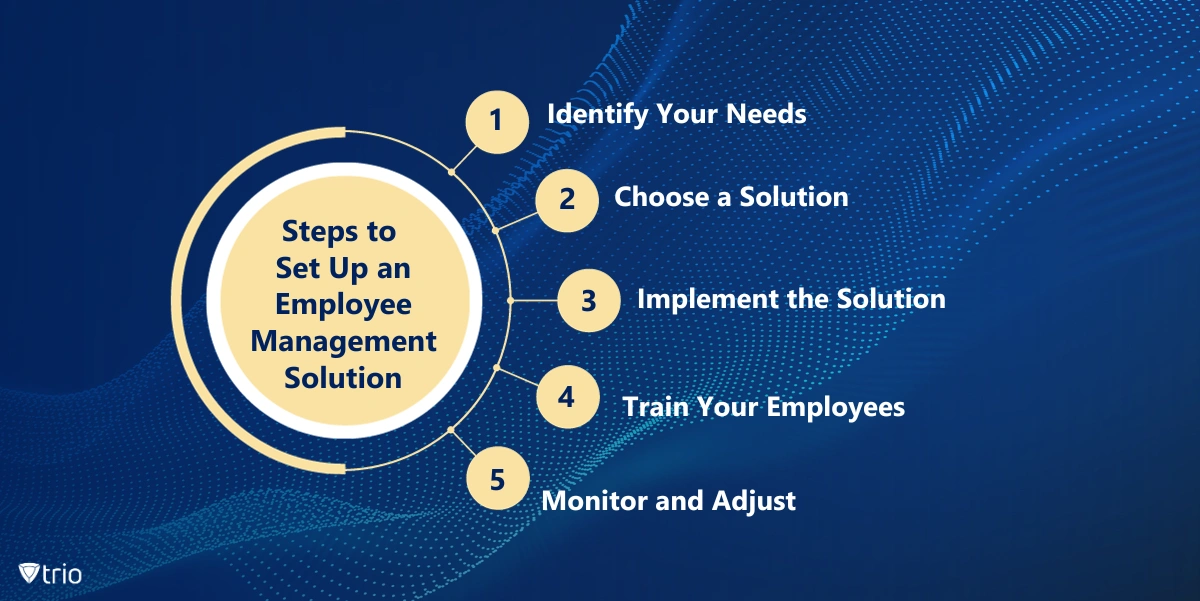Effective employee management is one way to increase efficiency, productivity, and security for businesses. In the simplest terms, employee management means efficiently managing and optimizing employee performance, productivity, and overall experience within an organization. Today, using mobile device management (MDM) software is crucial to an effective employee management system. This guide will delve into the nuances of employee management and how it can be optimized using MDM for IT administrators.
Understanding Employee Management
Employee management is a comprehensive approach aimed at optimizing employee performance and engagement in the workplace. It encompasses everything from hiring and onboarding to performance monitoring and improvement. In the context of IT administrators, it extends to managing and securing the digital tools and devices an employee uses in their work.
Employee management has evolved to include dedicated software solutions with the increasing dependence on technology in the workplace. These solutions, often called employee management software, provide a centralized platform for managing all aspects of an employee’s work life, including their devices, applications, and data access.
Components of an Employee Management Solution

-
Device Management
Device management means monitoring and managing all employee devices to ensure they are optimized for performance and security. MDM proves beneficial for this purpose. It allows IT administrators to enforce device security policies, automate device management tasks, and ensure devices are optimized for performance.
-
Security
Security is a crucial aspect of any employee management system and involves:
- Implementing strong security policies
- Enabling device encryption
- Limiting access to sensitive data
These procedures can mitigate the risk of data breaches and other security incidents, improving productivity and security.
-
Content Distribution
A comprehensive employee management solution should also facilitate seamless content distribution. This involves ensuring employees have the necessary resources and applications they need to perform their tasks effectively.
-
Communication and Employee Relationship Management
Effective communication is vital in any organization. Employee management software can also act as an employee relationship manager. A good employee management solution facilitates real-time messaging and file sharing, enhancing team productivity and collaboration.
Setting Up an Employee Management Solution
Setting up an employee management solution often requires a few key steps, which we will discuss in the following:
Step 1: Identify Your Needs
Above all, you should identify the specific needs of your organization, which requires understanding:
- The nature of your workforce
- The devices and applications they use
- The level of security required
Step 2: Choose a Solution
After identifying your needs, the next step is to choose a suitable employee management solution based on your organization’s needs and goals. You can select:
- An MDM software
- An employee management app
- A combination of both
Step 3: Implement the Solution
After choosing a solution, the next step is implementation. It involves:
- Installing the software on all employee devices
- Setting up user profiles
- Configuring the necessary settings
Step 4: Train Your Employees
Training will help your employees understand how to use the solution effectively and ensure they adhere to the set policies and procedures.
Step 5: Monitor and Adjust
Lastly, it’s important to continually monitor the effectiveness of your employee management solution. This includes tracking employee productivity, device performance, and security incidents. Use the results you gain from monitoring to adjust your solution to meet your needs better.

Managing Employees with an Employee Management Solution
When the employee management solution is in place, the next step is managing your employees, which involves:
- Monitoring employee performance
- Enforcing compliance with company policies
- Ensuring devices and data are secure
Here are some best practices for managing employees with an employee management solution:
Monitor Employee Performance
An effective employee management solution should provide tools for monitoring employee performance. This includes tracking work hours, task completion, and overall productivity.
Enforce Compliance
To enforce compliance with your company’s policies and procedures:
- Set up rules and restrictions on devices
- Monitor compliance
- Take action when necessary
Ensure Security
Security is a crucial aspect of employee management. You should:
- Implement strong security policies
- Monitor devices for potential threats
- Take swift action in the event of a security incident
Maintaining Your Employee Management Solution
Ensuring your employee management solution remains effective over time requires regular maintenance and a well-defined Employee Transition plan. Here are some best practices for maintaining your solution:
Regular Updates
As technology evolves, it’s important to update your employee management solution to leverage new features and improvements. This involves updating the software on all devices and making necessary adjustments to settings and policies.
Regular Audits
Conducting regular audits can help identify any potential issues or areas for improvement in your solution. This involves reviewing employee performance data, device performance data, and security incident reports.
Communication
Keeping your employees informed about any changes to your solution is crucial. You must try to:
- Provide regular updates
- Offering training sessions
- Address any concerns or questions your employees may have
Security Considerations for Employee Management
Implement Strong Security Policies
Implementing strong security policies is crucial for protecting your devices and data. This includes requiring strong passwords, enabling device encryption, and limiting access to sensitive data.
Monitor Devices
Regular monitoring devices can help identify and mitigate potential threats. This involves tracking device activity, checking for updates, and scanning for malware.
Protect Data
Protecting your data is a crucial aspect of security, which requires implementing data protection measures such as:
- Data encryption
- Secure data storage
- Data loss prevention
Introducing the Trio Mobile Device Management Solution
Trio offers a comprehensive mobile device management solution that can help IT administrators effectively manage their employees. With features like seamless profiling, monitored devices, dynamic logging, and efficient employee management, Trio offers a robust and intuitive platform for managing all aspects of an employee’s work life.
With Trio’s secure onboarding and offboarding process, you can ensure that your employees start their journey smoothly and that sensitive data is protected when an employee leaves the organization. Additionally, Trio’s automated approval processes can drastically reduce manual intervention and accelerate decision-making.
To learn more about how Trio can enhance your employee management, start your free trial here.
MDM for Employee Management: Conclusion
Employee management is crucial for any organization to ensure workforce efficiency, productivity, and security. With the right employee management solution, IT administrators can effectively manage and secure their employees’ devices, streamline workflows, and enhance productivity. With robust solutions like Trio, the process of employee management becomes even more streamlined and efficient.
Know about news
in your inbox
Our newsletter is the perfect way to stay informed about the latest updates,
features, and news related to our mobile device management software.
Subscribe today to stay in the know and get the most out of your mobile
devices with our MDM solution app.
Recent Posts

Erase the Risk: Protect with Zero Standing Privileges
Learn how zero standing privileges eliminate persistent access rights, enhance data security and reduce the risk of unauthorized access.

Understanding Access Control Types in Cybersecurity w/ Examples
Thorough understanding of access control types & the knowledge to make informed decisions about implementing security measures in your organization.

Cloud Data Protection: Safeguarding Information in the Cloud
Learn essential strategies for robust cloud data protection, exploring tools, best practices, and policies that safeguard sensitive information.





